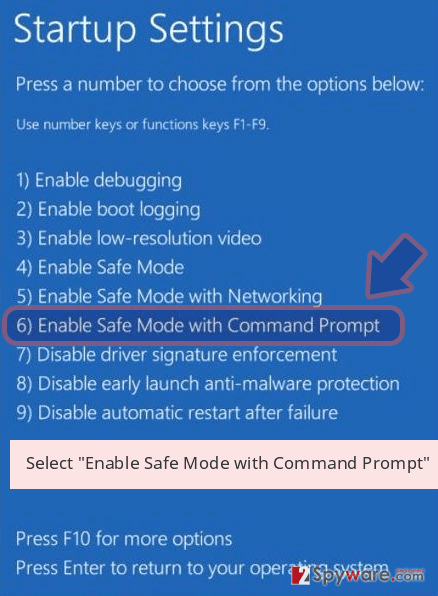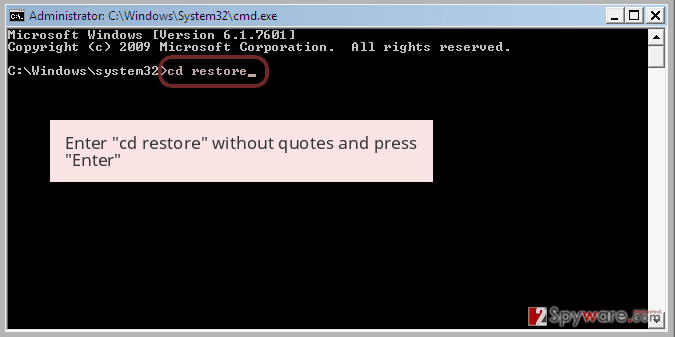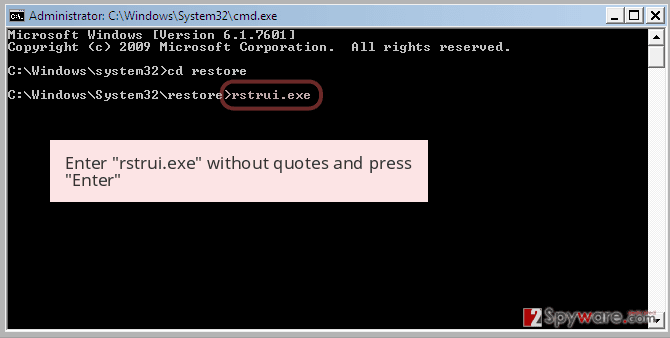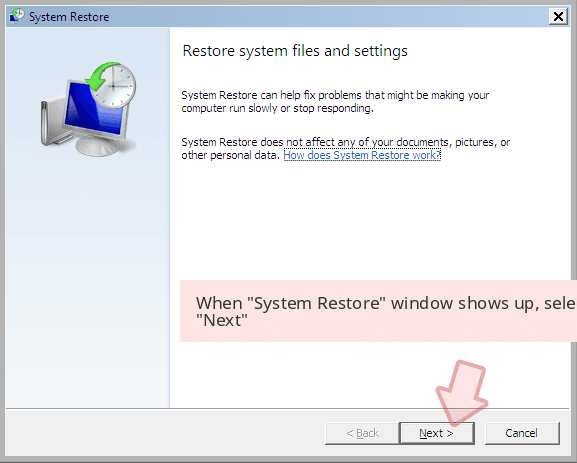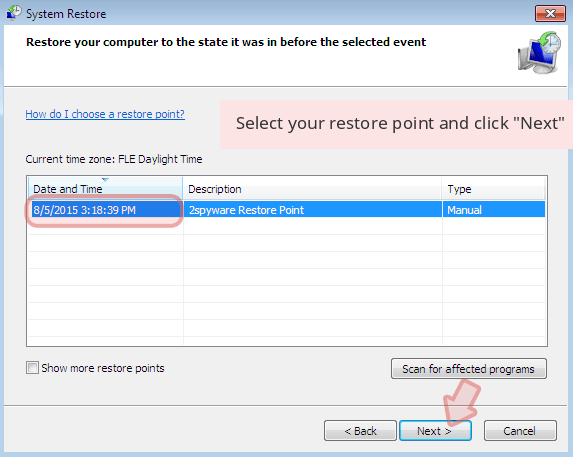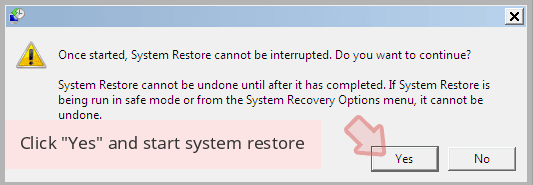Sanctions ransomware / virus (Recovery Instructions Included) - Virus Removal Instructions
Sanctions virus Removal Guide
What is Sanctions ransomware virus?
What should you expect from Sanctions ransomware virus?
Sanctions ransomware is a unique example of a file-encrypting virus. It has a political connotation and mocks America’s attempts to sanction Russia.[1] The developers’ beliefs are clearly illustrated in the caricature presented in the ransom note. The virus has been spotted on March 2017; however, it seems it hasn’t started spreading actively. According to the virus researchers, the developers might be launching targeted attacks instead of starting massive distribution campaigns. This crypto-malware uses a combination of AES-256 and RSA-2048 algorithms to encrypt targeted files. What is more, it appends the .wallet file extension to each targeted file. Typically this file extension is added by Dharma and CrySiS ransomware families; however, Sanctions virus is not related to them.
Following data encryption, the Sanctions ransomware leaves a ransom note called RESTORE_ALL_DATA.html. What is interesting, the letter has a link to a Satoshi box which allows uploading and selling files using Bitcoin currency. Probably, you can release that victims can purchase a decryption tool and recover their files for 6 Bitcoins. Indeed, it’s an enormous amount of money that equals 6.700 USD at the moment. However, we want to discourage you from this risky deal. It’s better to remove Sanctions from the system instead of hoping for the criminals’ good will. Nevertheless, you transfer the demanded sum of money; no one can assure that you will get safe and working decryption tool. Keep in mind that it is illegal business and hackers might play unfairly.[2] We recommend Sanctions removal with a help of FortectIntego. Detailed information about ransomware elimination is presented at the end of this article.
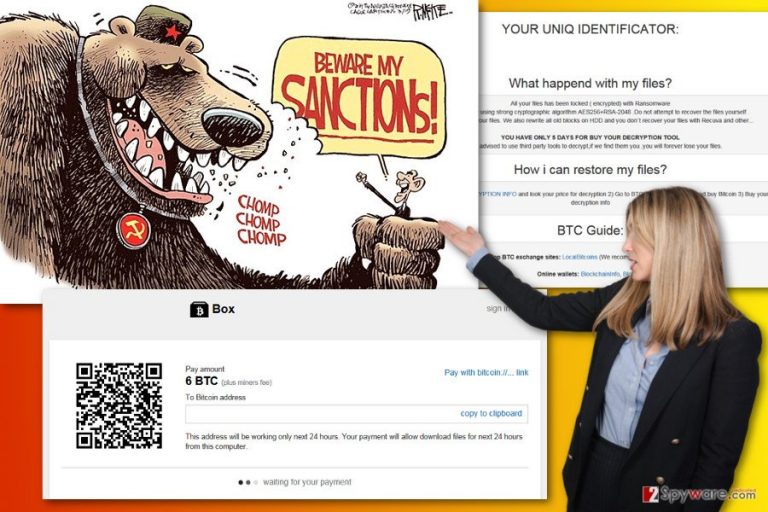
How can I avoid ransomware infection?
The specific methods how Sanctions ransomware virus is being distributed is still under the investigation. However, the majority of file-encrypting viruses are being spread using the same techniques and strategies. Last year, malicious spam emails and their attachments became number one malware distribution method.[3] Thus, it’s important to be careful with actions in your inbox and learn how to identify infected email[4] from the legitimate one. Another popular method is malvertising which gives criminals an opportunity to place malicious and misleading ads on various websites. Thus, before clicking on “too good to be true” or strange ads, you should evaluate the fact that click on it might cause the infiltration of crypto-malware such as Sanctions virus. Ransomware might also invade the system with a help of bogus software and updates, or use flaws in the computer’s security. Thus, keep all software installed on your PC updated, and find credible sources to download updates and necessary programs. As you can see, there are numerous ways how ransomware might attack your device and data. Hence, you should also backup your files regularly, and strengthen computer’s security with an antivirus program.
What to do after Sanctions ransomware attack?
After ransomware attack, computer users always are too much concerned about a possibility to recover their files. However, removal should be the priority. Thus, if you ever get infected with Sanctions malware, you should not focus on getting back your data. Do not even consider your chances to transfer the demanded sum of money and hope for the working and safe to use decryption tool. As we already told you, there is huge possibility to face a bigger damage. Of course, if you have never backed up your files,[5] you should not have high expectations to recover your data soon. However, you should try additional methods that might help to rescue at least some of your files. Though, first of all, you have to focus on Sanctions removal. Install reputable malware removal program, such as [d1[, SpyHunter 5Combo Cleaner or Malwarebytes. However, if you have problems with installing your chosen security tool, have a look at our prepared instructions. They will explain how to disable the virus in order to access security program and remove Sanctions automatically. Then, you can use data backups or other methods to restore encrypted files.
Getting rid of Sanctions virus. Follow these steps
Manual removal using Safe Mode
Sanctions ransomware might prevent you from installing antivirus program necessary for the virus removal. Therefore, if you cannot install or access your chosen tool, please follow the steps below and try again.
Important! →
Manual removal guide might be too complicated for regular computer users. It requires advanced IT knowledge to be performed correctly (if vital system files are removed or damaged, it might result in full Windows compromise), and it also might take hours to complete. Therefore, we highly advise using the automatic method provided above instead.
Step 1. Access Safe Mode with Networking
Manual malware removal should be best performed in the Safe Mode environment.
Windows 7 / Vista / XP
- Click Start > Shutdown > Restart > OK.
- When your computer becomes active, start pressing F8 button (if that does not work, try F2, F12, Del, etc. – it all depends on your motherboard model) multiple times until you see the Advanced Boot Options window.
- Select Safe Mode with Networking from the list.
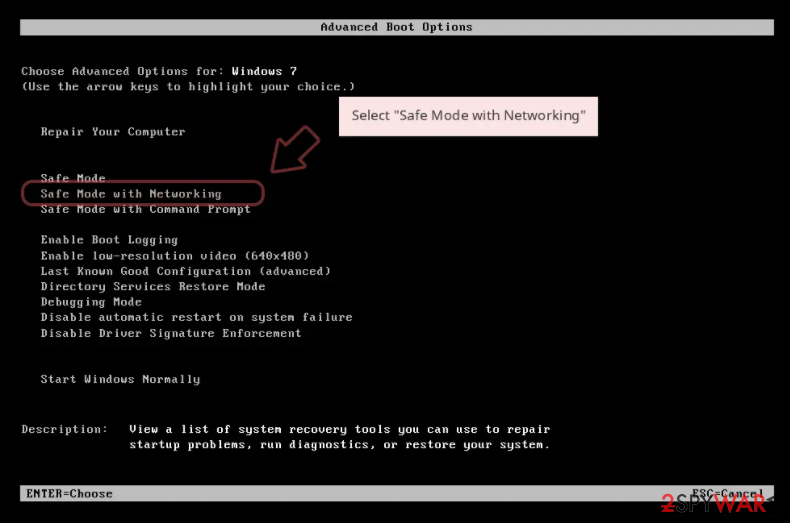
Windows 10 / Windows 8
- Right-click on Start button and select Settings.
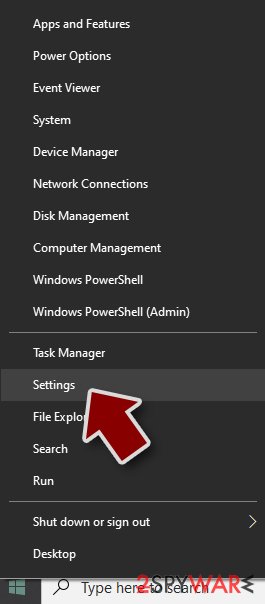
- Scroll down to pick Update & Security.
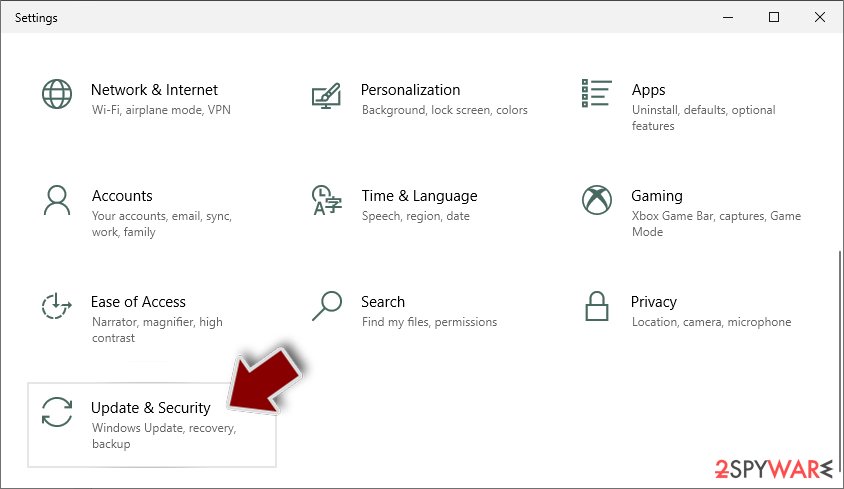
- On the left side of the window, pick Recovery.
- Now scroll down to find Advanced Startup section.
- Click Restart now.
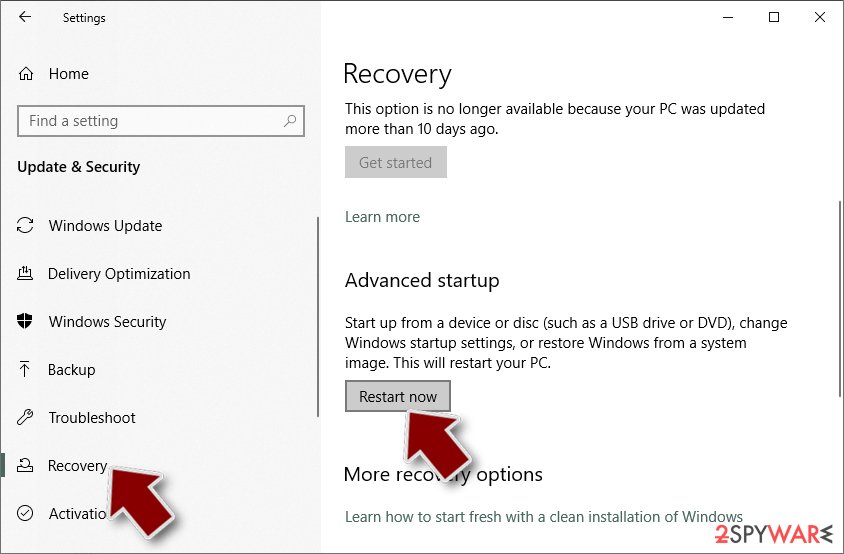
- Select Troubleshoot.
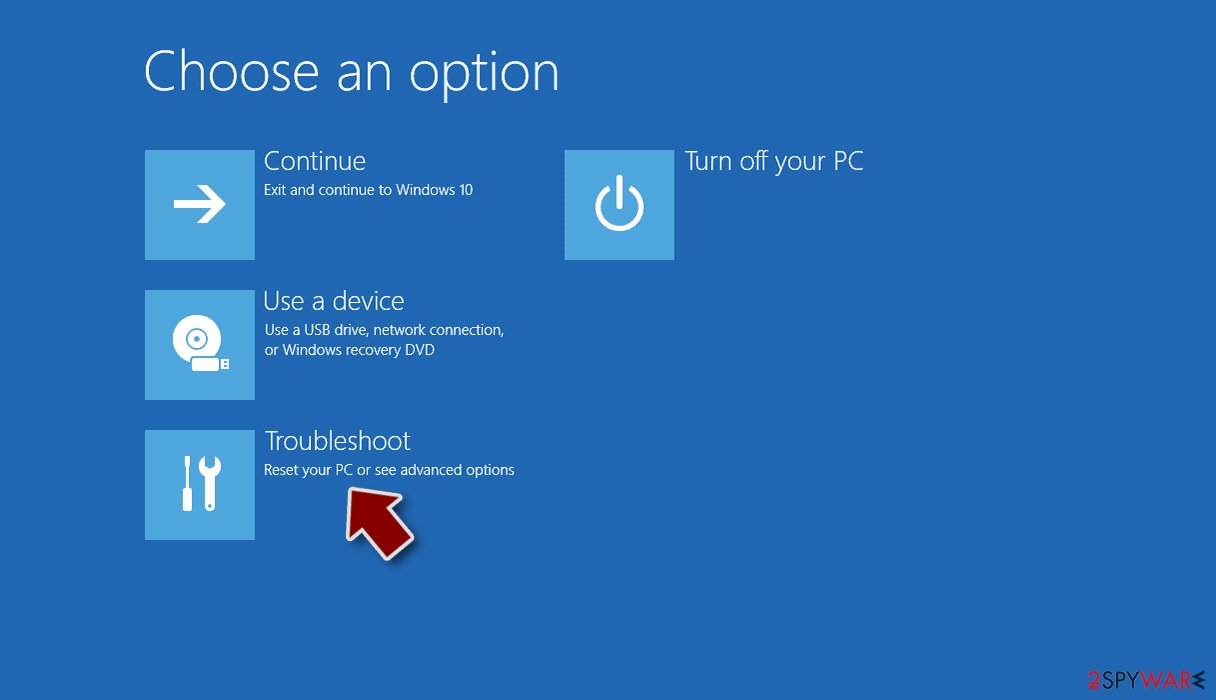
- Go to Advanced options.
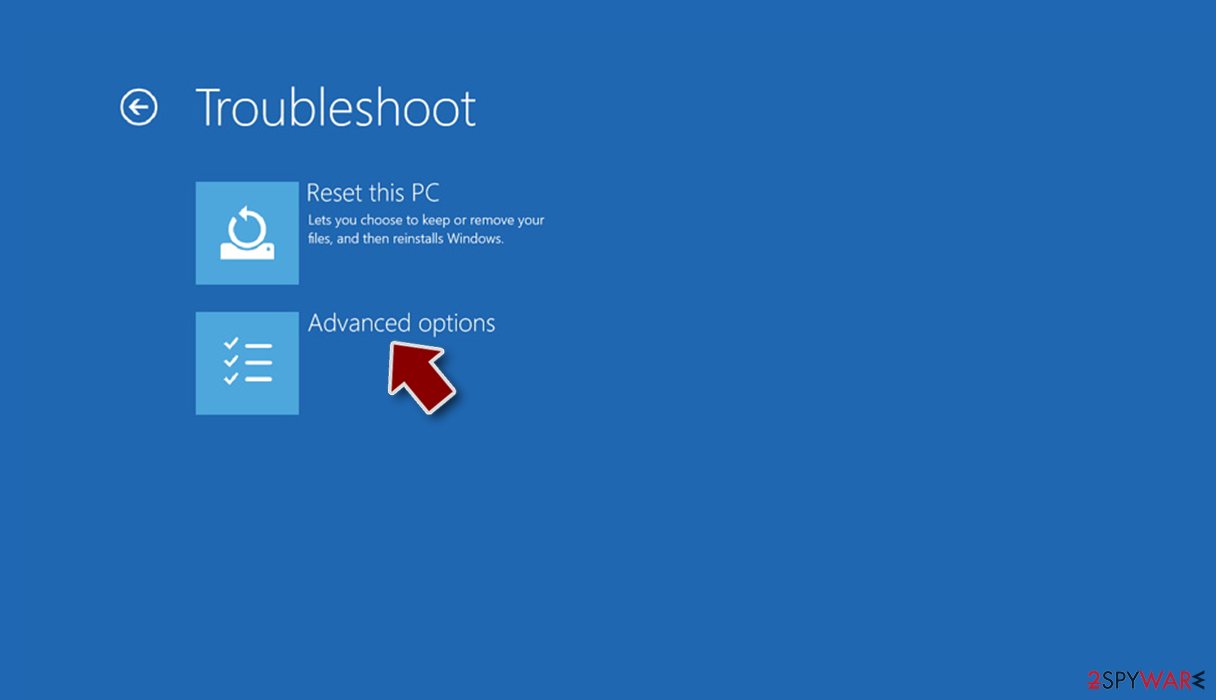
- Select Startup Settings.
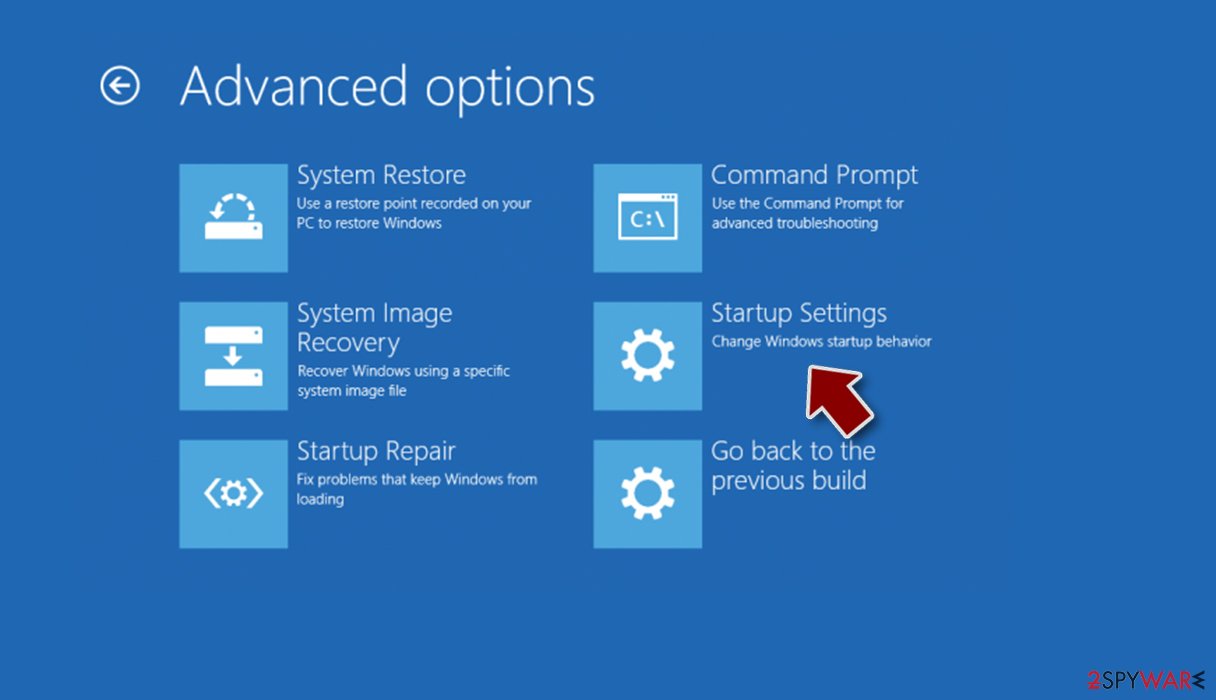
- Press Restart.
- Now press 5 or click 5) Enable Safe Mode with Networking.
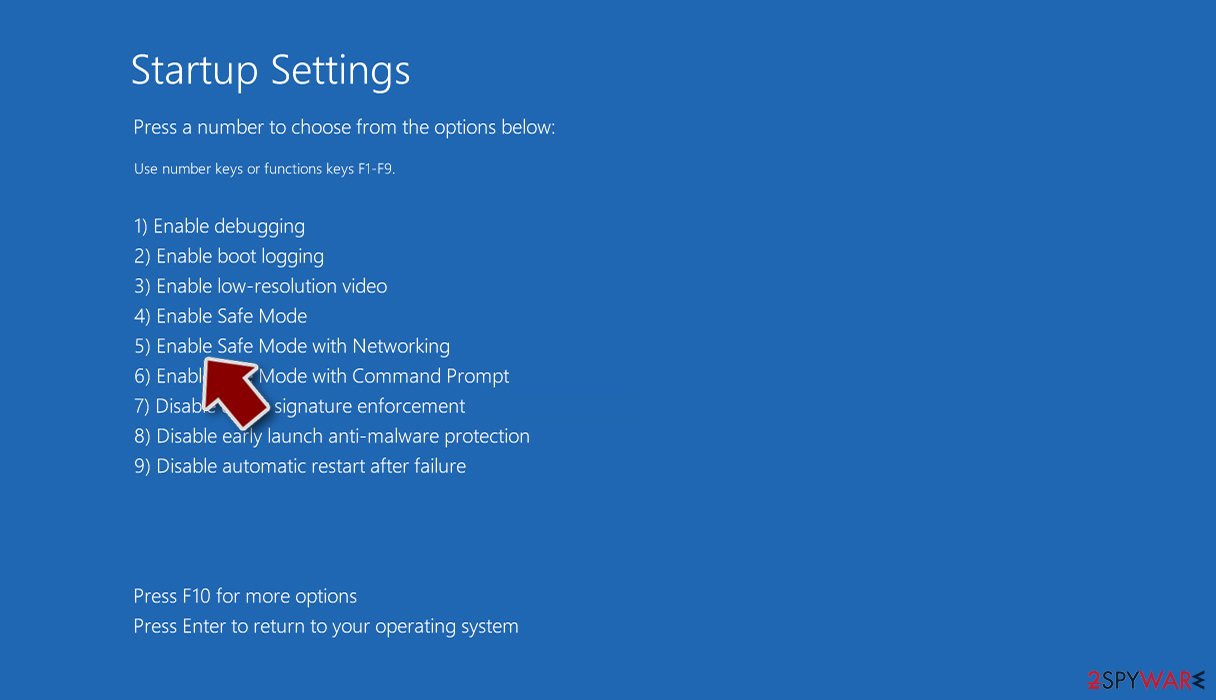
Step 2. Shut down suspicious processes
Windows Task Manager is a useful tool that shows all the processes running in the background. If malware is running a process, you need to shut it down:
- Press Ctrl + Shift + Esc on your keyboard to open Windows Task Manager.
- Click on More details.
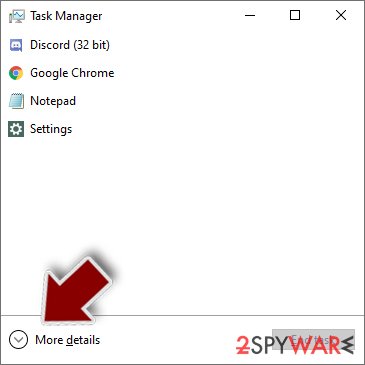
- Scroll down to Background processes section, and look for anything suspicious.
- Right-click and select Open file location.
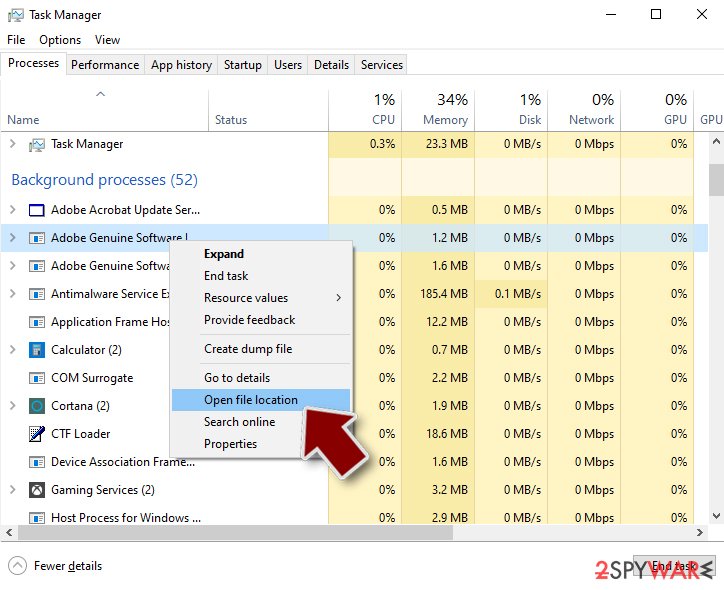
- Go back to the process, right-click and pick End Task.
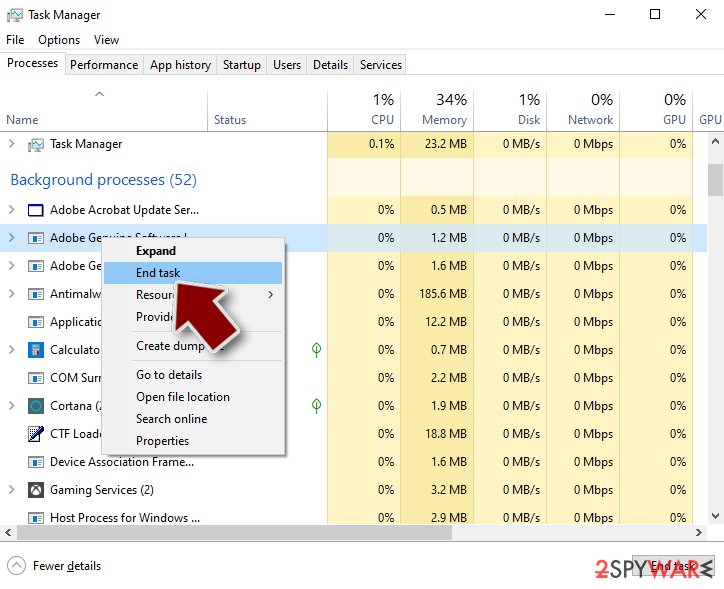
- Delete the contents of the malicious folder.
Step 3. Check program Startup
- Press Ctrl + Shift + Esc on your keyboard to open Windows Task Manager.
- Go to Startup tab.
- Right-click on the suspicious program and pick Disable.
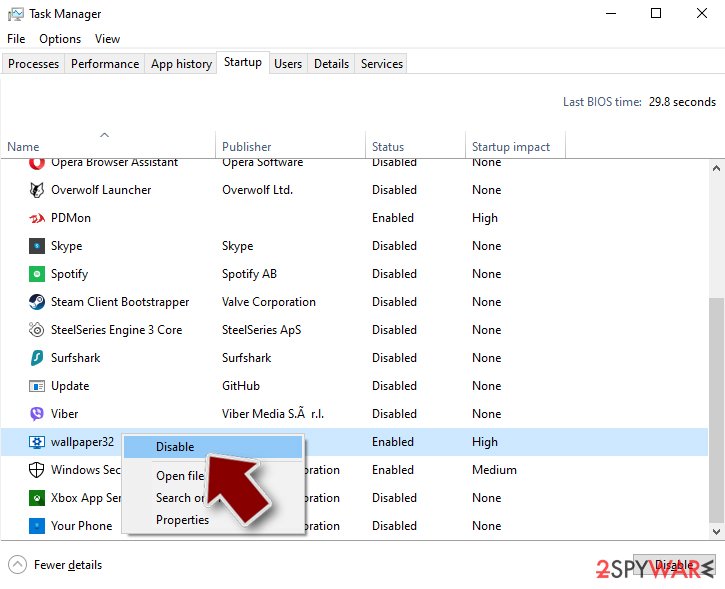
Step 4. Delete virus files
Malware-related files can be found in various places within your computer. Here are instructions that could help you find them:
- Type in Disk Cleanup in Windows search and press Enter.
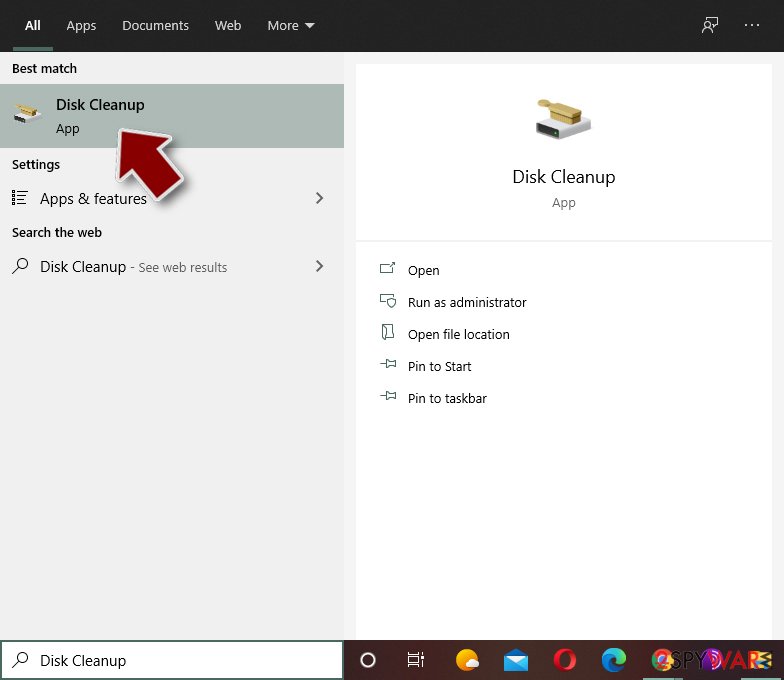
- Select the drive you want to clean (C: is your main drive by default and is likely to be the one that has malicious files in).
- Scroll through the Files to delete list and select the following:
Temporary Internet Files
Downloads
Recycle Bin
Temporary files - Pick Clean up system files.
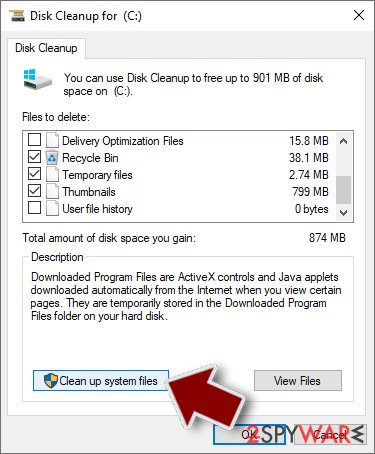
- You can also look for other malicious files hidden in the following folders (type these entries in Windows Search and press Enter):
%AppData%
%LocalAppData%
%ProgramData%
%WinDir%
After you are finished, reboot the PC in normal mode.
Remove Sanctions using System Restore
If System Restore method hasn’t helped to disable the virus and perform its automatic removal, try the second option.
-
Step 1: Reboot your computer to Safe Mode with Command Prompt
Windows 7 / Vista / XP- Click Start → Shutdown → Restart → OK.
- When your computer becomes active, start pressing F8 multiple times until you see the Advanced Boot Options window.
-
Select Command Prompt from the list

Windows 10 / Windows 8- Press the Power button at the Windows login screen. Now press and hold Shift, which is on your keyboard, and click Restart..
- Now select Troubleshoot → Advanced options → Startup Settings and finally press Restart.
-
Once your computer becomes active, select Enable Safe Mode with Command Prompt in Startup Settings window.

-
Step 2: Restore your system files and settings
-
Once the Command Prompt window shows up, enter cd restore and click Enter.

-
Now type rstrui.exe and press Enter again..

-
When a new window shows up, click Next and select your restore point that is prior the infiltration of Sanctions. After doing that, click Next.


-
Now click Yes to start system restore.

-
Once the Command Prompt window shows up, enter cd restore and click Enter.
Bonus: Recover your data
Guide which is presented above is supposed to help you remove Sanctions from your computer. To recover your encrypted files, we recommend using a detailed guide prepared by 2-spyware.com security experts.If you do not have data backups, please do not risk and pay the ransom for the cyber criminals. We highly recommend trying alternative recovery methods that might help to restore at least some of your files.
If your files are encrypted by Sanctions, you can use several methods to restore them:
Restore the files encrypted by Sanctions ransomware with a help of Data Recovery Pro
Originally, this professional tool has been created to restore missing, corrupted or accidentally deleted files. However, developers updated this tool, and now it helps to restore some files encrypted by crypto-malware. Thus, give it a try!
- Download Data Recovery Pro;
- Follow the steps of Data Recovery Setup and install the program on your computer;
- Launch it and scan your computer for files encrypted by Sanctions ransomware;
- Restore them.
Take advantage of Windows Previous Versions feature to restore files encrypted by Sanctions malware
This method allows traveling back in computer’s time and copying the previously saved version of the encrypted files. Obviously, this method is complicated and inconvenient if you want to restore a lot of files; however, it might be your only option. Besides, this method only helps victims who enabled System Restore function before Sanctions virus attack.
- Find an encrypted file you need to restore and right-click on it;
- Select “Properties” and go to “Previous versions” tab;
- Here, check each of available copies of the file in “Folder versions”. You should select the version you want to recover and click “Restore”.
Use ShadowExplorer to restore files encrypted by Sanctions virus
If Sanctions malware hasn’t deleted Shadow Volume Copies that are crucial for data recovery, ShadowExplorer will help you to restore encrypted files.
- Download Shadow Explorer (http://shadowexplorer.com/);
- Follow a Shadow Explorer Setup Wizard and install this application on your computer;
- Launch the program and go through the drop down menu on the top left corner to select the disk of your encrypted data. Check what folders are there;
- Right-click on the folder you want to restore and select “Export”. You can also select where you want it to be stored.
Sanctions decryptor is not available yet
As soon as malware researchers release Sanctions decrypter, we will update the information. Now you should be patient and take the best of the previously explained alternative recovery methods.
Finally, you should always think about the protection of crypto-ransomwares. In order to protect your computer from Sanctions and other ransomwares, use a reputable anti-spyware, such as FortectIntego, SpyHunter 5Combo Cleaner or Malwarebytes
How to prevent from getting ransomware
Access your website securely from any location
When you work on the domain, site, blog, or different project that requires constant management, content creation, or coding, you may need to connect to the server and content management service more often. The best solution for creating a tighter network could be a dedicated/fixed IP address.
If you make your IP address static and set to your device, you can connect to the CMS from any location and do not create any additional issues for the server or network manager that needs to monitor connections and activities. VPN software providers like Private Internet Access can help you with such settings and offer the option to control the online reputation and manage projects easily from any part of the world.
Recover files after data-affecting malware attacks
While much of the data can be accidentally deleted due to various reasons, malware is one of the main culprits that can cause loss of pictures, documents, videos, and other important files. More serious malware infections lead to significant data loss when your documents, system files, and images get encrypted. In particular, ransomware is is a type of malware that focuses on such functions, so your files become useless without an ability to access them.
Even though there is little to no possibility to recover after file-locking threats, some applications have features for data recovery in the system. In some cases, Data Recovery Pro can also help to recover at least some portion of your data after data-locking virus infection or general cyber infection.
- ^ Akbar Shahid Ahmed, Ryan J. Reilly. Barack Obama Sanctions Russia Over Election Meddling. The Huffington Post. News, blogs and original content offering coverage of US politics, entertainment, style, world news, technology and comedy.
- ^ Paying for ransomware could cost you more than just the ransom. Trend Micro Blog. The blog about online security.
- ^ The amount of malicious spam reaches all time high in Q3, 2016. Kaspersky Lab. The official site of Newsroom Europe.
- ^ Chris Hoffman. How To Spot A Dangerous Email Attachment. MakeUseOf. The website covers information and tips on various gadgets.
- ^ Whitson Gordon. There's No Excuse for Not Backing Up Your Computer. Do It Now. Lifehacker.Tips, tricks and downloads for getting things done.

